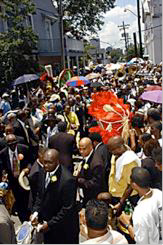
Mardi Gras Indian Community
Since the 1800s, working-class Blacks in New Orleans paid tribute to Native Americans who aided escaped slaves on their routes to safety by “masking Indian”: building and donning elaborate costumes for Mardi Gras, fashioned from layers upon layers of feathers, beads, sequins, and billowing fabrics dyed in energetic colors. For 52 years, Allison “Tootie” Montana, a construction worker and chief of the chief of these Mardi Gras Indians, lead the parade: His signature, three-dimensional geometric designs often weighed hundreds of pounds, costs thousands of dollars, and earned him a National Endowments for the Arts grant, and was the subject of feature-length documentary. On July 10, 2005, thousands New Orleans residents gathered to march in his funeral procession, out of respect for his art, and his advocacy for this community.
Montana was a long-time, outspoken advocate for Mardi Gras Indians, who often faced discrimination from local law enforcement. On the night of his death, he addressed the City Council, along with other chiefs, to protest police brutality, as well as efforts to squash Mardi Gras Indian parades and other public gatherings. Moments later he collapsed on the floor, and was taken to a nearby hospital, where he was pronounced dead of a heart attack. His funeral procession, which drew both non-Indians and Indians, was one of the largest to trickle down the well-known parade route from the church to the cemetery; participants beat tambourines, chanted, and moved like rhythmic clouds of aqua, orange, red, and yellow smoke.
[ About Living as Form | Curator Statement | About the artists ]


